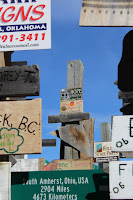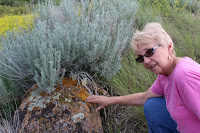Friday morning we met for our bus tour of
Whitehorse. We had an excellent driver
who really knew the history and changes that have occurred in the city. One of our first stops was at the hydro
electric plant which is a dam that has generators that provides electricity to
the city. But, before construction
could begin a plan for fish ladders had to be made to prevent the interference of the spawning of the salmon. The fish ladder is a wooden trough which slopes uphill allowing the salmon to swim to the top of the dam. The salmon must have a way to travel upstream to the area where they were born. It was interesting that the salmon swim over 2000 miles from the Bering Sea up the Yukon River to spawn.
could begin a plan for fish ladders had to be made to prevent the interference of the spawning of the salmon. The fish ladder is a wooden trough which slopes uphill allowing the salmon to swim to the top of the dam. The salmon must have a way to travel upstream to the area where they were born. It was interesting that the salmon swim over 2000 miles from the Bering Sea up the Yukon River to spawn.
Today the spray from the gates of the dam is similar to
the spray that was created many years ago by rapids and whirlpools. This spray gave the city its name because it
reminded them of the mane of a white horse.
We also stopped at the Klondike II which was a ship that
was used to transport supplies, ore from the mines, and passengers. This was critical to the Yukon area because
it was the only feasible transportation at the time. The boats were steam driven paddlewheelers
which were able to travel up and down the shallow river. Even though this was the best transportation
available it still took 36 hours to travel from Dawson City to Whitehorse. Today the trip can be made in less than 9
hours.
Later in the day we drove along the river and saw the
float plane harbor. Today small planes provide a valuable service to remote
areas which may not be accessible by cars and trucks. In the winter the same planes are retro
fitted with skis so that they can continue be of assistance to the backwoods
areas.4
 The Transportation Museum was a must see for us. In front
of the building is a full size DC 3 airplane which has been mounted on a
pedestal and allows the plane to turn in the wind. It has been dubbed the world’s largest weather
vane”.
The Transportation Museum was a must see for us. In front
of the building is a full size DC 3 airplane which has been mounted on a
pedestal and allows the plane to turn in the wind. It has been dubbed the world’s largest weather
vane”.
We saw the” Queen”, which was a
sister plane to “The Spirit of St. Louis” plane that was flown by Charles Lindbergh.




































